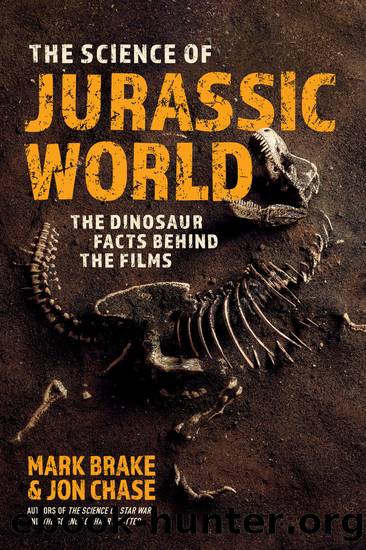The Science of Jurassic World: The Dinosaur Facts Behind the Films by Mark Brake & Jon Chase

Author:Mark Brake & Jon Chase [Brake, Mark & Chase, Jon]
Language: eng
Format: epub
Tags: science, reference, essays, General
ISBN: 9781510762596
Google: AtADEAAAQBAJ
Publisher: Simon and Schuster
Published: 2021-06-15T23:47:36.142813+00:00
Size Matters
There were many small herbivorous dinosaurs, but a good deal were megaherbivores weighing over 2,200 pounds, with some larger sauropods coming in at around 80 tons. According to an observation known as the Jarman-Bell Principle, the bigger an herbivoreâs body mass, the less selective it is of food and the poorer quality its diet is. Bigger animals tend to be less picky eaters but can pack in more bulk to gain sufficient nutrition. Generally, animals that arenât so picky about their food and just whack the whole thing in are known as bulk feeders.
On the other hand, some animals are selective feeders who tend to go for choice parts of a plant or even stick to particular species. Regarding this feeding strategy in a megaherbivore, it was noted by South African researchers in 2012 that, âDespite their narrow selection for plant species, large size coupled with hindgut digestion enables elephants to exploit a wide range of plant parts, including fibrous stems, bark, and roots.â So, their large size and guts allowed them to still indulge in a wide range of vegetation.
Mesozoic megaherbivores were avid eaters and relied on bulky plants that could regenerate quickly, such as conifers and ginkgoes. Although, all plants werenât created equal, and experiments on horsetails and conifers such as Araucaria (e.g., monkey puzzle trees) have shown that when fermented, most of them release more energy than many ferns, cycads, and podocarp conifers. Additionally, in 2019, a team lead by Carole Gee from the University of Bonn reported that horsetail was likely an important âsuperfoodâ for young sauropods, helping with their fast growth in early stages of life.
Generally, as young dinosaurs grew, they occupied different niches depending on their size and specific features. For example, a new hatchling might compete for resources with small mammals and reptiles but as a juvenile may occupy a niche alongside midsized herbivores like pachycephalosaurs. The young may not just be smaller copies of the adults, either. Sometimes different parts of their anatomy grow at different rates, meaning that their growth is allometric. This is seen in sauropods, and the related growth changes can provide indications about their diets at different stages of life.
For instance, recent research into a small diplodocid skull collected in Montana in 2010 revealed that the youngster (nicknamed Andrew) had peg teeth at the front and spatula-like teeth at the rear of the jaws. This is different from the adults that typically have one type of teeth and implies that their diet may have been more varied at that stage of life compared to when they get older. (This would be useful knowledge to have when feeding the baby dinosaurs of Jurassic World that are seen running around a fenced-off pen for the amusement of visiting kids.)
Download
This site does not store any files on its server. We only index and link to content provided by other sites. Please contact the content providers to delete copyright contents if any and email us, we'll remove relevant links or contents immediately.
Kathy Andrews Collection by Kathy Andrews(11730)
The remains of the day by Kazuo Ishiguro(8822)
Paper Towns by Green John(5089)
Spare by Prince Harry The Duke of Sussex(5072)
Industrial Automation from Scratch: A hands-on guide to using sensors, actuators, PLCs, HMIs, and SCADA to automate industrial processes by Olushola Akande(4980)
The Body: A Guide for Occupants by Bill Bryson(4974)
Machine Learning at Scale with H2O by Gregory Keys | David Whiting(4179)
Be in a Treehouse by Pete Nelson(3947)
Never by Ken Follett(3790)
Harry Potter and the Goblet Of Fire by J.K. Rowling(3774)
Goodbye Paradise(3728)
Into Thin Air by Jon Krakauer(3313)
The Remains of the Day by Kazuo Ishiguro(3293)
The Cellar by Natasha Preston(3262)
The Genius of Japanese Carpentry by Azby Brown(3224)
Fairy Tale by Stephen King(3220)
120 Days of Sodom by Marquis de Sade(3180)
The Man Who Died Twice by Richard Osman(2997)
Drawing Shortcuts: Developing Quick Drawing Skills Using Today's Technology by Leggitt Jim(2996)
